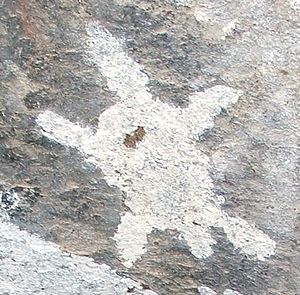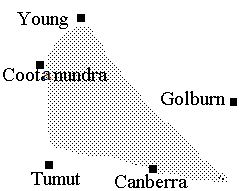Ngunnawal facts for kids

The Ngunnawal people (sometimes spelled Ngunawal) are an Aboriginal group from southern New South Wales and the Australian Capital Territory in Australia. They are the traditional owners of the land where Australia's capital city, Canberra, is located.
Contents
Ngunnawal Language
The Ngunnawal people traditionally spoke the Ngunnawal language. This language is part of the large Pama-Nyungan language family. It is very similar to the Gundungurra language, spoken by the Gandangara people. Some experts even consider them different ways of speaking the same language. The Ngunnawal language is also related to the Ngarigo language.
Ngunnawal Country
When Europeans first arrived in the 1820s, the Ngunnawal-speaking people lived in this area. Their traditional land stretched from towns like Goulburn and Yass down to Lake George. To the west, it reached the Goodradigbee River.
More recent studies show that the Ngunnawal country mainly covered the land around the Yass River. This area extended between Lake George in the east and the Murrumbidgee River in the west. The southern border of their land was just north of Canberra.
Sometimes, the Ngunnawal country is thought to include a wider area. This larger area could reach as far north as near Young. If this is true, their population in the 1830s would have been over a thousand people.
A big battle for land ownership happened at Sutton. An invading Ngunnawal group fought the Nyamudy people who lived there. The Nyamudy won, which set the Ngunnawal country's southern border. It did not go further south along the Yass River than Gundaroo.
Neighbouring Peoples
The Ngunnawal people lived north of the Nyamudy/Namadgi people. The Nyamudy lived to the south on the Limestone Plains, where Canberra is now. The Wiradjuri people lived to the west of the Ngunnawal. The Gundungurra people were their neighbours to the north.
Land Ownership Discussions
Today, there are ongoing discussions about who are the traditional owners of the Canberra area. Several Aboriginal groups are involved in these talks. These groups include the Ngambri, the Ngarigo, and the Walgalu speaking Ngambri-Guumaal.
Early settlers in the 1830s wrote about three main groups in the region. These were the Ngunnawal, the Nyamudy/Namadgi, and the Ngarigo.
In 2012, a report for the ACT Government looked into the history of land ownership. It found that the language spoken in the Canberra region was a dialect of Ngarigu. This dialect was related to, but different from, languages spoken in other areas. The report also said that there wasn't enough clear information from the 1700s onwards. This made it hard to fully support any family's claims to be the original owners.
Some Aboriginal people in the Canberra area identify as Ngambri. For example, Matilda House identifies this way. Another person, Shane Mortimer, calls himself one of the Ngambri-Guumwaal. He says Guumwaal means "high country" in a language. However, many other local Aboriginal people disagree with this claim. They say the Ngambri are a small family group who took their name from the Sullivan's Creek area in the late 1990s.
Evidence of Early Occupation
The oldest direct proof of Aboriginal people living in this area comes from a rock shelter. This shelter is near Birrigai, close to Tharwa. Evidence from this site shows people lived there about 25,000 years ago. However, it is likely that people lived in the region even earlier than that. This is based on older sites found in nearby areas.
European farmers began to settle in the Yass area in the 1820s. This gradually led to the Ngunnawal people being moved from their traditional lands. Some Ngunnawal people found work on the new farms in the region. In 1826, many Aboriginal people at Lake George protested an incident involving a shepherd. The protesters eventually moved away peacefully.
Historical records from Australia once claimed that the last "full-blooded" Ngunnawal person, Nellie Hamilton, died in 1897. However, many Indigenous and non-Indigenous Australians disagree with this. There are many Ngunnawal people living today who continue their culture and traditions.


